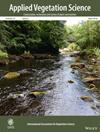Response of herbaceous functional types and woody vegetation to selective shrub control on wildlife and cattle ranches in a semi-arid savanna
Abstract
Aims
Shrub encroachment is a major challenge for livestock and wildlife management in semi-arid savannas. Shrub removal by land managers is widespread, but the long-term effects on vegetation structure and composition, which determine carrying capacity for herbivores, are poorly documented. This study aims to examine the effects of selective shrub removal to guide vegetation management in key land uses of semi-arid African savannas.
Questions
Vegetation responses were assessed across land uses and treatments to answer the following questions: (1) does shrub removal increase the frequency of palatable plants and therefore herbivore-carrying capacity; (2) does selective shrub removal decrease woody vegetation structure 15 years after application; and (3) how do these effects differ between cattle and wildlife ranching?
Location
Molopo region of the North West Province, South Africa.
Methods
Herbaceous and woody vegetations were sampled within six transects each of three wildlife ranches and three cattle ranches in areas that had either been selectively shrub-controlled with herbicides 10–15 years previously or left untreated. To quantify effects of woody shrub control on herbaceous functional-group abundances and assemblages, tree equivalents, regrowth rate, and shrub abundance, we compared these variables across two treatments (treated and untreated) and land uses. Data were analysed using GLMMs, NMDS ordinations, PERMANOVA, and SIMPER.
Results
Selective shrub control effectively improved palatable herbaceous vegetation, especially on cattle ranches. Especially abundance of perennial grass was higher on wildlife ranches compared to cattle ranches. Tree equivalent was higher in untreated compared to treated plots, and these differences were more pronounced on wildlife ranches than on cattle ranches.
Conclusionss
Selective shrub removal improved the palatable herbaceous layer for both wildlife and cattle ranching and can be considered an effective management strategy in semi-arid rangelands.


 求助内容:
求助内容: 应助结果提醒方式:
应助结果提醒方式:


